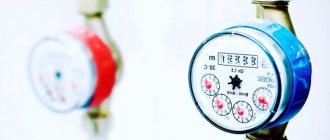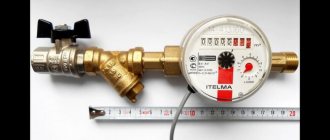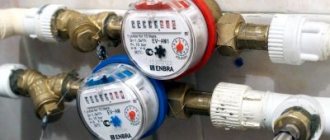The volumes of water use established by the standards are noticeably overestimated. They are much more than its actual consumption. With the increase in water tariffs, the issue of saving becomes relevant. You can save something only if you keep track of your consumption.
To pay less, you need to install a water meter. But there are so many varieties of this device that it can be difficult to navigate when choosing. You don’t know how the types of water meters offered by different manufacturers differ from each other? We will help you resolve this issue.
The article discusses the types of water meters, their features and operating principle. Photo and video recommendations are provided, and rules for choosing the best option for use at home are listed. Taking into account our advice, purchasing a meter will become extremely simple.
Features of tachometer counters
This type of water meters is the most common. They operate on a simple principle.
Positive and negative characteristics
Mechanical water meters are compact. They can be installed in remote places, so they do not spoil the interior of the room. The simplicity of the design allows these devices to be priced at an acceptable price for most consumers. The error in their readings is insignificant.
Tachometer counters are non-volatile devices. The main element in their design is the impeller placed in the water. The volume of water is calculated by the number of revolutions it makes.
The following characteristics are considered negative:
- blade wear;
- sensitivity to impurities present in water;
- dependence of water meter readings on the magnetic field;
- inability to record instantaneous flow;
- the presence of moving elements in the flow chamber.
Despite the presence of shortcomings, if you follow the verification schedule, the meter can last up to 12 years. The device does not require external power supplies to operate.
Operating principle and design
The main element of the meter is the impeller. It has a perpendicular orientation of its axis relative to the direction of the water supply. The nominal diameter of a device of this type does not exceed 50 mm.
Tachometer meters are installed to measure the flow of both cold and hot water, if we are talking about small volumes. These water meters are not designed for high flow rates.
When an avalanche of water transits through the impeller, it moves in a circle. Each is accompanied by the pouring of a certain amount of liquid through the device. The more pressure the water creates, the faster the impeller rotates.
A sensitive counting mechanism receives information about the number of revolutions through the gearbox, and all changes are shown by the dial.
Devices with an impeller can be single-jet, multi-jet, or combined. First, water is supplied to the input blades in one stream. A magnetic coupling sends a torsional impulse to the counting unit indicator. Experts advise installing such meters on hot water pipelines with a cross-section of 15 to 30 mm.
In multi-jet models, the flow is broken into parts on the way to the impeller. The measurement error decreases because the blades are exposed to the same force. In this case, flow turbulence is completely eliminated.
The device is designed for installation on cold water pipes with a maximum diameter of 50 mm. This water meter is ergonomic and easy to install and dismantle if you need to perform verification.
When the coverage of water use measurements needs to be expanded, a combined type tachometer device is installed. It is understood that with a change in the flow rate, one counter comes into operation. The transition occurs automatically.
A combined meter consists of a main and an additional device. The first is activated by opening the valve when large volumes of water are consumed
There is only one measuring unit, it is highly accurate and sealed, so it works even in flood conditions. For pipe diameters greater than 50 mm, a rotating turbine is installed in the design of the device instead of an impeller. In this case, the water meter is installed along the axis of the main line. The ideal place to install it is at the entrance.
Such meters are installed on pipelines of industrial enterprises with a cross-section of up to 500 mm, where significant volumes of water flow. The direction and angle of the flow is determined by a special fairing.
Dry and wet-propelled devices
Based on the location of the counting device, tachometer water meters are divided into dry and wet running. In the first case, the liquid has no effect on the counting mechanism. The rotational movement from the impeller is transmitted to it through a special magnetic coupling.
The mechanism is protected from corrosion by an impenetrable partition. The model has a fairly high cost, but it can be used even where hot water is supplied, which contains foreign impurities in large quantities.
In addition, the accuracy of the readings of such a device is very high. If there is a need for remote data acquisition, you can include a pulse output device in the system.
Mount the pulse output unit directly at the pipeline inlet. The information transformed into an impulse is sent to the recording device
The module collecting information can be located at any distance from the measurement site.
In a wet-flow device, the counting unit is in constant contact with dirty liquid. This negatively affects the duration of its service. To correct the situation, a filter is installed in front of the meter.
Classification by mechanism of operation
You can find a wide variety of meters on the market. They are represented by household and industrial options, both domestic and imported. The main thing is not only to choose the right water meter, but also to install it correctly.
It is better to buy meters in specialized stores
Classification of water meters by operating mechanism:
- Tachometer. The principle of operation of the device is to place the impeller in a system that is connected to the metering mechanism.
- Electromagnetic. Can be found in industry. They work due to a magnetic field and moving fluid.
- Ultrasonic. When a stream of water passes through an ultrasonic field, the water flow rate is measured.
- Vortex. A special element is placed in the fluid flow. The flow speed is proportional to the frequency of the vortices.
Tachometer devices have the simplest operating principle. The main thing is to place an impeller or turbine in the flow. Depending on the submerged element, water meters are either vane or turbine. Among the winged ones you can find single-jet and multi-jet ones. Turbine options come with mechanical and induction counters.
The type of action in vane and turbine meters can be dry or wet. In this case, a pulse output may be available, but this is not necessary.
The tachometer water meter is compact, accessible and accurate. It can last up to 12 years, which has been tested in practice. These devices are often found in apartment buildings and private buildings.
Electromagnetic water meters
This type of appliance cannot do its job without electricity. The basis of its functioning is the property of water to pass electric current.
Electromagnetic water meters are characterized by high data accuracy. The measurement of readings is based on the parameters of the interaction of the magnetic field and water flow
When a liquid overcomes a magnetic field obtained artificially, it changes its parameters, sensors record this, and the data appears on the display. This is an expensive type of meter. It serves well and for a long time if the pipes are free of scale. Because such conditions are rare, electromagnetic devices are used infrequently.
Main pros and cons
If high accuracy of readings is the main advantage of electromagnetic water meters, then the complexity of installation is their main disadvantage. They need a power source. When the electricity goes out, the house will be left without water, since the device will cut off its supply.
The advantages include the following:
- large measurement range;
- absence of moving elements in the flow chamber;
- instant display of consumption;
- data archiving.
Installing a meter does not entail a large increase in resistance to water pressure. For this reason, it is often installed on low pressure pipelines.
Among other disadvantages, it should be noted the uneven distribution of liquid velocity over the diameter of the meter and susceptibility to flow turbulence.
Features of installing an electromagnetic meter
When installing such a meter, you must not forget about filters. They must be present in the system, since the magnet attracts grains of metal present in the water. It’s good if two filters are installed - a standard mud filter and a magnetic one.
The electromagnetic meter controls the flow of water with different temperature parameters and viscosity over a wide range. The structure of the flow converter includes a magnetically permeable cylinder with an electromagnetic coating inside and electromagnetic windings located outside
The measuring signal is taken through two electrodes, which are located diametrically and are in contact with water. They install meters in metal-plastic, metal, plastic pipes in the bathroom and toilet.
Advantages and features of choosing a tachometer water meter?
The main advantages of a tachometer water meter include:
- affordable cost;
- independence from power supply;
- compact dimensions;
- ease of installation;
- high reliability and long service life.
If the diameter of the pipeline does not exceed 4 cm, a device with an impeller is suitable. If the diameter is from 5 to 20 cm, it is worth purchasing a turbine water meter. There are also combined devices equipped with both an impeller and a turbine. However, they are not widely used. They are mainly used in facilities where there are sudden changes in water pressure.
Choosing which water meter to install in your apartment should also take into account the design features of the device. Tachometer water meters are divided into:
- single-jet. A single stream of liquid passes through the impeller (turbine). The indicator, using magnetic couplings, reads the number of revolutions of the working element and transmits them to a computing mechanism, which converts this quantity into cubic meters;
- multi-jet. In front of the turbine (impeller), the water flow is divided into several jets. This solution allows us to minimize measurement error. Therefore, this counter is considered more accurate. Its advantages also include ease of dismantling, during which only the computing mechanism is removed.
It is difficult to answer unequivocally which water meter to install in an apartment - single-jet or multi-jet. Both types can be equipped with pulse output modules and integrated into the general house metering system. Although the single-jet has a larger error, it will not be noticeable within one apartment. It should be noted that single-jet vane water meters are designed for operation at water temperatures up to 90 degrees Celsius, multi-jet vane and all turbine devices can withstand temperatures up to 120 degrees Celsius.
Ultrasonic type of devices
These meters are universal, with their help they measure not only water consumption, but also calculate the volume of gas and steam. They, just like electromechanical devices, cannot function without power supply, since they have an electronic counting device, which is simply inoperable without it.
The measurements are carried out by the influence of ultrasonic vibrations on the water flow. The resulting acoustic effect is analyzed by the sensor, and then the readings appear on the display.
They are mounted both on the surface of the water pipe and directly in it. If the installation is performed using the first method, the device can be quickly moved to another location to perform calibration of other meters or temporary control. As a rule, such devices are used in industry.
In addition to stationary ultrasonic meters, there are also portable devices. Their design contains two sensors that work both as transmitters and receivers
Ultrasonic water meters have low power consumption, which allows them to be used in many areas. The device is well protected from interference. The measurement error with these devices is a maximum of 1%.
The design of such water flow meters does not contain parts that can break, so they practically do not become unusable. The latest models of such types of water meters as ultrasonic ones successfully combine good metrological qualities, accuracy and appropriate cost.
They are equipped with lithium batteries that maintain their performance for more than 5 years. They also provide automatic adjustment at certain time intervals, which raises the measurement accuracy to a higher level.
The disadvantages of the equipment include the need for an external power supply or autonomous. Another negative point is that the measurement accuracy is reduced due to the presence of air bubbles in the water.
Types and types of water meters
There are several types of water meters, but they can all be divided into two main groups: non-volatile (use mechanical processes) and volatile (require electricity).
In general, there are four types of counters:
Tachometer water meters with impeller
Tachometer (turbine or impeller). Refers to mechanical devices (non-volatile). The main working part is a small turbine or impeller, which is located in the water. The amount of water is calculated by the number of revolutions the impeller makes. The revolutions of the impeller axis cause the mechanical counter to move. It works with any water (hard, with a high iron content, etc.), but the accuracy of the readings is not very high; there is a possibility that after a few years the impeller will become overgrown and begin to rotate more slowly. But it may happen that it will spin faster than necessary. In general, the option is inexpensive and meters of this type are mainly installed in apartments.- Induction or electromagnetic. This device requires electricity to operate. The operation of the device is based on the ability of water to conduct electricity. The device is expensive, has a long service life - more than 10 years, and in the absence of foreign inclusions in the water and rust/scale in the pipes, provides accurate data. Since clear water and ideal condition of the pipeline are not about our networks, they are installed infrequently.
Electromagnetic (induction) water meter - Ultrasonic. They also require power supply. The principle of operation is to compare the speed of ultrasound propagation “along” and “against” the flow. The accuracy is high, but also only on clean pipes. The price is even higher, although the service life is around 15 years.
- Vortex. They analyze the rate of formation of a vortex street behind an obstacle of a special shape. The behavior of the water vortex is analyzed by an electronic device (power supply is also required). They work normally only with clean water without impurities, the service life is about 8 years.
From all that has been said above, it turns out that in our real conditions - old pipes and not the cleanest water - only tachometer meters are suitable. They are basically installed.
Ultrasonic water meter
Read how to choose polypropylene pipes here.
Vortex water meters and their features
Vortex meters can operate stably only if the water in the pipeline is clean and free of abrasive particles that can distort the readings.
Each vortex counter contains a streamlined body. It is placed in a pipe and acts as an obstacle to the flow of water. Further along the flow direction there is a highly sensitive sensor. It reacts to the slightest pressure fluctuations in the flow.
The sensor that is equipped with the vortex counter is characterized by excellent balancing. Even pipe vibration does not affect the accuracy of its readings
When the speed of a moving fluid reaches a certain value, vortices appear outside the obstacle. They are formed alternately from different sides and move with the flow. In this case, zones of low and high pressure appear. This gives rise to a phenomenon called a “vortex street.”
Vortexes appear with a frequency proportional to the speed of the moving flow. The distance between adjacent vortices corresponds to the volume of water flowing during the corresponding period. Therefore, the flow rate can be calculated by multiplying the number of vortices by the volume. The higher the flow speed, the more often vortices occur.
The vortex counter can be improved by adding a temperature controller. In this case, the measurement accuracy will increase when adjusted for temperature.
The average service life of the device is 8 years. The main purpose is to regulate technological processes. It is irrational to use such devices in water distribution in an apartment.
What types of water meters are there?
In practice, four types of devices that control water flow are used. Their classification is based on the principle of action, which can be:
- Ultrasonic. Flow is determined by the speed of propagation of high-frequency oscillations. Below is a simplified design of such a device.
Previously, such devices were not used in everyday life due to their high cost, but recently models at affordable prices have appeared on the market. Distinctive features: high accuracy and long service life.
Operating principle of ultrasonic water meter
- Vikhrev. The operation of such devices is based on the analysis of pressure changes caused by the emergence of vortices due to the placement of a bluff body in the flow of the working medium. The structure of such a device is clearly demonstrated in Figure 4.
Basically, such devices are used to control technological processes in production. Not used in everyday life.
Vortex water meter device
- Electromagnetic. Flow speed is measured by measuring the strength of the electromagnetic field, which changes under the influence of the flow of the working medium.
The features of the device do not imply its installation on small-diameter pipes, which makes it impossible to use such devices as a water flow meter in an apartment or private house.
Operating principle of an electromagnetic water meter
- Mechanical (tachometer). The lower figure demonstrates the principle of the device.
Tachometer cross-section
Designations:
- A – Water supply.
- B – Turbine.
- C – Transfer device.
- D – Mechanical indicator.
The operating principle of such devices is quite simple: under the influence of water flow (A in Fig. 6), the turbine (B) rotates, while rotating the transmission device (C) connected to a mechanical multi-segment digital indicator (D). The main advantages of such devices:
- Simple design.
- Low cost.
- Independence from power supply.
Disadvantages include:
- Criticality of the composition and “purity” of water, mechanical impurities and the presence of mineral salts, as well as other impurities, lead to the turbine stopping, that is, to breakdown of the device. After this, you will have to submit an application to the water utility and install a new device. Therefore, such devices require the installation of a filter, which needs regular cleaning.
- Short service life compared to other types of devices.
Despite these disadvantages, it is the latter type of device that is used as a household flow meter.
5. Electronic tachometer devices
According to the Decree of the Government of the Russian Federation No. 3541 of August 27, 2012, regulating the provision of utility services, the installation of multi-tariff devices for metering hot water supply is allowed. In addition to mechanics, such devices are equipped with a microprocessor, thanks to which water consumption is recorded at several rates, depending on the temperature of the working flow.
The advantages of such devices are obvious:
- Payment is made depending on the quality of services provided. That is, if the hot water is not at sufficient temperature, its consumption is calculated at a reduced rate.
- Many devices are equipped with an interface that allows you to transfer data about the readings of the device to the company providing water supply services (subject to the implementation of such a possibility).
The features of such devices include:
The relatively high cost, which pays off within two years, taking into account the service life of 8-10 years, this is completely justified.
The need for a built-in power supply with a service life of 5-6 years. Such a battery is replaced when the device is checked. This procedure is performed every three to four years, depending on the type of device.
The meaning of inscriptions and symbols on meters
Symbols and inscriptions on water meters can tell a lot about the device. Therefore, you need to learn to decipher them in order to find out certain capabilities of the product and determine which meter is suitable for specific conditions.
Manufacturers put four main designations on devices:
- Qmax is the maximum flow rate that does not cause errors in the operation of the device. The device can operate at this flow rate for a maximum of 1 hour. This must be followed by a break.
- Qn is the optimal flow rate for the water meter. In relation to its maximum capability, this parameter is 50% less. In the case when a volume of water equal to the normal flow rate passes through the body of the device, it will function flawlessly. The device will be able to pass verification and will not have to be replaced with a new one for a long time.
- Qmin is the lowest flow rate that gives the smallest error when measuring water flow.
- Qt is the pressure at which it is unprofitable to operate a water measuring device, since it begins to operate with a significant error. At the same time, it is difficult to predict what sign the error value will have - it can be either a minus or a plus to the actual readings.
In addition to these designations, the maximum temperature at which the device can operate is marked on the body of the water meter.
There are meters for hot and cold liquids on sale. There are also universal ones that operate in a wide temperature range without errors.
Cold water flow meters have the inscription 40 °C and the housing is blue. The casing of flow meters for hot water is red or, which is much less common, black. On this background there will definitely be the inscription 90 °C.
If water whose temperature exceeds 90 °C is centrally supplied under pressure, you need to select the meter marked 150 °C.
Differences between cold and hot water meters
There are several types of meters on the market. The most popular are water meters for hot and cold water. The appearance of the equipment has virtually no differences. Cold water meters are designated by the letter “X”. For hot water, use the letter "G".
Meters should be checked from time to time
For hot and cold water meters, different verification periods are provided. The difference is 2 years. This is a significant gap that cannot be ignored. Thus, hot water meters have a more reliable design than cold water meters.
If you install a cold water meter on a hot one, the risk of frequent leaks increases. But when installing hot water devices on cold water, no problems with the equipment will arise.
Hot water meters are made of materials that can withstand not only high temperatures, but also their possible changes. For this equipment, verification is carried out more often, because the mechanism can fail at any time.
Installing a water meter begins with its selection. It is necessary to study not only the names of the devices, but also their characteristics and features. The classification of water metering devices is quite broad. In this case, the internal mechanism, the type of submersible element and the number of possible connection nodes are taken into account. The purpose of the meter is also taken into account.
Tips for choosing a flow meter
Knowing what water meters are available for sale, when choosing, you need to decide on the purpose of installing the meter. If its installation is necessary in order to know how many cubic meters of cold water have been consumed, expensive meters are not needed.
A simple “wet” tachometer option is quite suitable here, you just need to first agree with the water supply company about its class.
A tachometer water meter is also suitable for a pipeline with hot water, but in a “dry” version so that the impurities in the water do not damage the measuring module. For a system where the flow is characterized by sudden changes, it is better to choose a combination device.
The lower the permissible error, the higher the accuracy class of the meter. This parameter increases from “A” to “D” . Devices used in everyday life have accuracy class “B” if they are oriented for horizontal installation. For vertical installation, “A” class is acceptable. Class “C” is typical for electronic meters installed in any position.
If the residents of a high-rise building decide to install a common water meter, the best option would be a water meter with a remote sensor
Taking into account the technical side when choosing a meter is mandatory, but it is equally important to take into account the fact that the device matches the location in which you want to install it.
If the device needs to be hidden in a niche, under the toilet or under the bathtub, then you should definitely think about what shape of the housing will “fit” into the free space. In one case, a device with a short body is suitable, in another - an elongated one.
The orientation of the counter relative to the floor is also important when choosing. It can be positioned vertically or horizontally. The main thing is that the data is easy to read. If the device’s counting mechanism is oriented horizontally, then the product itself should occupy this position.
The meter display displays the readings of the cubes used. These are the first five digits, the remaining 6 or 8 digits are liters. They are not taken into account when paying. There are water flow meters where there are no liters at all
There are water meters whose digital display is located in such a way that readings can only be taken if it is mounted vertically. Since hot and cold water have different prices, payments are made to different bills.
Popular brands and models
Paying for utilities is a fairly serious part of expenses. You have to spend a lot on hot water. This is why many owners resort to installing water meters.
When choosing water meters, you may be faced with a large selection of equipment. Purchasing the best option is not easy.
Don't buy water meters that are too cheap
Popular water meter models:
- SV-15G – tachometer water meter with an impeller. Can be mounted both on a horizontal pipeline and on a vertical one. The design is strong enough to prevent leaks. At the same time, the device has powerful dual-circuit protection against magnetic fields.
- SVK-15 is a tachometer-type vane counter. Can last 3-4 years. This is an option for an apartment or office.
- VSG-15 – household option. The product range may include meters with different dimensions. When choosing, they rely on the pipeline, which allows you to install a water meter both in the apartment and in the basement. The design includes watch jewels for more accurate measurements and longer life. The mechanism can operate independently of the impeller.
- VSKM 90 is a multi-jet tachometer counter. The diameter of the pipes ranges from 15 to 50 ml. The design includes watch stones.
- LV-4T – a device with a sensor. The design has a four-rate temperature sensor. This helps reduce the cost of hot water according to the tariff. It all depends on the water temperature.
For billing at a liquid temperature of 40-45 degrees, a coefficient of 0.7 is used. When the reading rises to 49 degrees, a factor of 0.1 is applied. The unit coefficient is relevant for temperatures above 50 degrees. But if the water is below 40 degrees, then the readings will not be taken into account.
The best counter manufacturers
The market is rich in water meters, both domestic and imported. Among the domestic manufacturers, the best are considered:
- "Betar";
- "Economy";
- "Meter"
- "Staroruspribor";
- "Triton".
The devices of these companies are cheaper than foreign ones and cope well with the tasks assigned to them. The main thing is that they are adapted to our realities to the maximum.
Among the imported models, the following have won the greatest consumer trust:
- Zenner (Germany);
- Wehrle (Germany);
- Actaris (France);
- Viterra (Germany);
- Siemens (Germany).
They have a large calibration interval and traditionally high reliability. We must not forget the fact that they are designed for water of a higher quality than that which flows in our water pipes.
Therefore, you need to be prepared for breakdowns, so it doesn’t hurt to find out if there are service centers nearby.
Why do you need water metering?
Despite the obviousness of the answer, many segments of the population are in no hurry to install metering devices until there is an official order. This inertia is caused by the fact that over many years, when water utility services cost mere pennies, we did not pay attention to consumption standards. With rising prices for utilities, this expense item has increased significantly. Based on this, we can list all the advantages of installing a hot and cold water flow meter:
- Let's start with the fact that companies providing water supply services, a priori, will not operate at a loss. Consequently, they will try to shift all their expenses onto the shoulders of consumers. When you see a broken main that has been leaking water near your home for weeks, know that its costs are paid by those who pay according to consumption rates.
- Excessive consumption rates. The second factor is directly related to the first, but we highlighted it separately to show its scale. Let's take St. Petersburg, for example, according to the 2021 regulation, cold water consumption per person is 220 liters per day, hot water - 150 liters. Let us repeat, for each person registered in the apartment. This is even higher than SNiP standards.
- The owners went on vacation and were not at home, it happens, but the receipt must be paid.
- Owners of private houses may have noticed that the receipt has added the cost of “irrigation”, which is directly related to the area of the plot, and it does not matter whether something is growing there or a garage is installed. Moreover, in the latter case, you can find an additional point for water consumption for washing the car.
The listed factors are quite sufficient to explain the need to install water meters.








